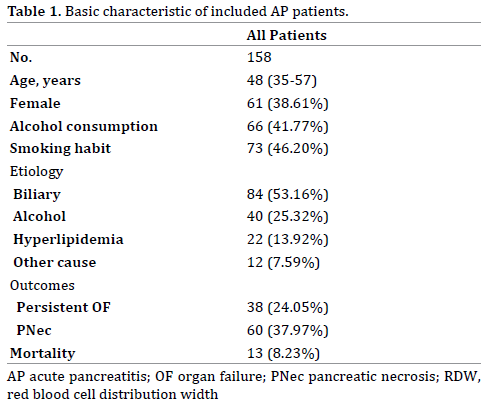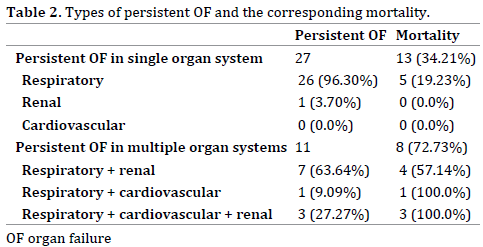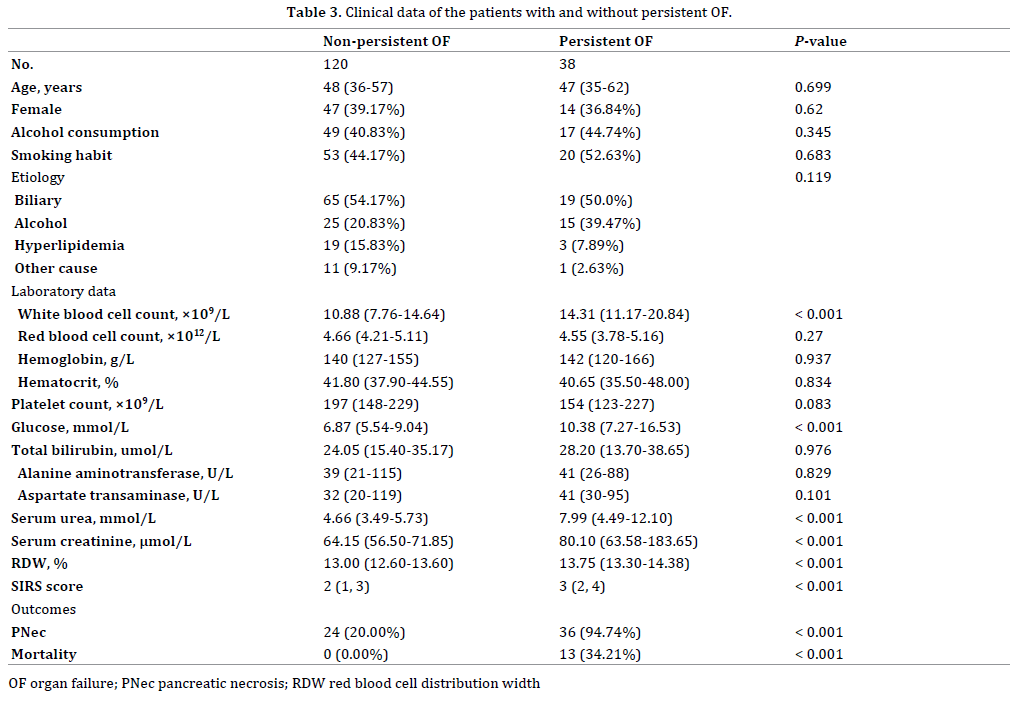Original Article - (2017) Volume 18, Issue 5
Department of Pancreatic Surgery, Union Hospital, Tongji Medical College, Huazhong University of Science and Technology, Wuhan 430022, China
Received June 29th, 2017 - Accepted August 30th, 2017
Aim Red cell distribution width is a parameter reflecting the size variability of peripheral erythrocytes. The elevation of red cell distribution width was correlated with adverse outcomes in several clinical conditions. Study has shown that red cell distribution width was predictive of mortality in acute pancreatitis. Acute pancreatitis patients with persistent organ failure show extremely high morbidity and mortality. The association underlying red cell distribution width and POF in acute pancreatitis has not been elucidated. Methods From March 2016 to January 2017, consecutive patients with confirmed acute pancreatitis were included in this retrospective study. Clinical parameters upon presentation, assessments concerning organ failure and disease outcomes were compared between patients with and without persistent organ failure. Logistic regression analyses were used to evaluate the relationship between red cell distribution width and persistent organ failure. Results A total of 158 patients, including 38 with persistent organ failure, were included. Compared to patients without persistent organ failure, persistent OF ones showed a significantly higher median value of red cell distribution width upon presentation (13.75 [13.30-14.38] % vs. 13.00 [12.60-13.60] %, P<0.001). After unit-and multi-variable analysis, red cell distribution width remained an independent risk factor for persistent organ failure (Hazard ratio 2.26, 95% confident interval: 1.46-3.51; P<0.001). Red cell distribution width predicted persistent organ failure with an area under the curve of 0.791, a sensitivity with 97.4% and specificity with 55.8%, respectively. The best cut-off value was 13.05 %. Conclusion Our results indicate that admission red cell distribution width is independently related with persistent organ failure in acute pancreatitis and may act as an early predictor.
pancreatitis; Erythrocyte Indices
AP acute pancreatitis; AUC area under the curve; OF organ failure; RDW red cell distribution width
Acute pancreatitis (AP) is a disorder featured by local and systemic inflammatory response, which is observed clinically as a spectrum varying from a mild, self-limited disorder to systemic inflammation, organ failure (OF) and even mortality [1]. According to 2012 revised Atlanta classification, severe AP has been redefined as AP with persistent OF (OF lasts more than 48 hours) with a mortality rate of 20-60% [2, 3, 4, 5, 6]. Early identification of severe AP is fundamental for the determination of therapeutic strategy and efficient management since effective intervention could significantly decrease morbidity and mortality of severe pancreatitis [7, 8].
Red cell distribution width (RDW) is a parameter reflecting the size variability of peripheral erythrocytes. It is one part of the complete blood count test. Elevated level of RDW represents greater heterogeneity of red cells. Higher RDW values were strongly associated with increased deaths from cardiovascular disease, cancer and other causes in older adults [9], and allcause mortality irrespective of nutritional deficiencies in both middle-aged and older adults [10]. Elevated RDW level was a predictor of mortality in patients with Gram-negative bacteremia [11] and was significantly related with higher rates of 90-day mortality and severe morbidity in young patients with community acquired pneumonia [12]. RDW was an independent predictor of 1-year mortality and re-hospitalization in patients with acute decompensated heart failure [13], and 30- day mortality in patients with acute dyspnea [14]. Increased RDW was significantly associated with in-hospital-, ICU-, and 1-year mortality in unselected critically ill patients [15], and an increase in RDW from baseline during the first 72 hours after hospitalization is significantly associated with 28-day and 90-day mortality in patients with severe sepsis or septic shock [16]. Moreover, two recent studies demonstrated that RDW was predictive of mortality in AP [17, 18].
However, the association underlying RDW and persistent OF in AP has not been fully elucidated yet.
Patient Selection
We performed a retrospective study of AP patients admitted to the department of Pancreatic Surgery in Union Hospital (Wuhan, China) between March 2016 and January 2017. Diagnosis of AP was made if one met with more than 2 of the following 3 criteria: 1) abdominal pain; 2) serum lipase and/or serum amylase elevated more than 3 times of the upper normal limit; 3) abdominal imaging including computed tomography (CT) or magnetic resonance imaging (MRI) shows AP characteristics [2]. The exclusion criteria were as follows: 1) age smaller than 18 years; 2) the time from symptom onset to hospital presentation ≥48 hours; 3) patients without CT or MRI scan; 4) patients with insufficient clinical record; 5) trauma-induced pancreatitis; 6) chronic pancreatitis (Figure 1).
Admission laboratory information were obtained from the blood test results upon presentation. The automated Coulter Counter Model S-Plus Jr (Coulter Electronics, Hialeah, FL) was used to measure the value of RDW. The medical records of patients were reviewed by one independent physician for data on basic demographics, pre-existing comorbidities, and disease severity. The study was conducted according to the Declaration of Helsinki principles. Informed consent was waived because all of the related data were acquired retrospectively from the hospital recording system, thus no additional laboratory assessments were needed. The study was approved by the ethics review board of Union Hospital (Wuhan, China).
Definitions
Severity of AP was defined according to the 2012 revised Atlanta criteria [2]. OF was determined when the following cutoffs were exceeded: 1) failure of respiratory system when PaO2/FiO2 was less than 300 mmHg; 2) failure of renal system when creatinine was ≥1.9 mg/ dl; and 3) failure of cardiovascular system when systolic blood pressure was less than 90 mmHg despite fluid resuscitation. When OF lasts ≥48 h, persistent OF was identified. Pancreatic necrosis (PNec) was diagnosed if contrast-enhanced computed tomography (CECT) showed non-enhanced area of pancreatic parenchymal and/or peri-pancreatic part [2].
Statistical Analysis
Statistical analysis was conducted with SPSS 20.0 (Chicago IL, USA). Continuous data are presented as median (interquartile range). Categorical variables are reported as number (%). Mann-Whitney U and Student’s t tests were performed to assess the differences between two study groups. Log-rank test was used for uni-variable analysis. Parameters showing statistical significance in uni-variable analysis were included in multi-variable regression. Cox regression model was utilized for multivariable analysis. Hazard ratios (HRs) and associated 95% confidence intervals (95% CIs) are shown. We used receiver-operator characteristic (ROC) curves to evaluate the predictive ability and its positive predictive value (PPV), negative predictive value (NPV), sensitivity and specificity of different parameters. P<0.05 was considered as statistical significance.
Patient Characteristics
A total of 158 AP patients admitted to our department during the period were included in this study. Baseline characteristics of these patients are presented in Table 1. The median age was 48 years and 61 (38.16%) of the patients were females. Overall, 38 patients developed persistent OF. 27 patients were identified as persistent OF in single organ system. Multiple persistent OF was observed in 11 patients (7 of the lung and the kidney, 1 of the lung and the heart, and 3 of all three organs). During hospitalization, 13 patients with POF died with an overall mortality of 8.23%. No death was found in AP patients without persistent OF (Table 2).


Comparison between Patients with and without Persistent OF
The comparison of basic characteristics between the two groups was shown in Table 3. Age, gender, smoking and drinking habits, and disease etiology were not different between patients with and without persistent OF. The levels of white blood cell count, glucose, urea, creatinine and RDW were statistically higher in patients with POF. While the values of red blood cell count, hemoglobin, hematocrit, platelet, total bilirubin, alanine aminotransferase, and aspartate transaminase showed no significant differences between the two groups. Moreover, SIRS score on admission was significantly higher in persistent OF ones.

Admission RDW as an Independent Predictor for Persistent OF
In order to further investigate the association between RDW and incidence of persistent OF, we used logistic regression model. We included white blood cell count, glucose, RDW and SIRS score in uni-variable analysis. The results suggested they were all correlated significantly with the incidence of persistent OF. As white blood cell count was included in SIRS score, we decided to exclude it from multi-variable analysis. On multi-variable regression, RDW and glucose were identified as independent prognostic factors (HR: 2.26, 95%CI 1.46-3.51; P<0.001 for RDW and HR: 1.18, 95%CI 1.06-1.32; P = 0.003) (Table 4).

As shown in Table 5, the area under curve of the receiver operating characteristic (AUC) for prediction of POF was 0.791 (95%CI: 0.722-0.860) of RDW, which was superior to that of glucose (0.737 [95%CI: 0.637- 0.837]) and SIRS score (0.691 [95%CI: 0.607- 0.775]). RDW showed a sensitivity of 97.4%, specificity of 55.8%, PPV of 41.1%, and NPV of 98.5%. The optimal threshold was 13.05 %.

In this study, we revealed that admission RDW was an independent prognostic parameter of persistent OF in patients with AP. Moreover, the predictive value was superior to scores of SIRS and Ranson’s criteria.
Although a majority of patients with AP have a mild course of the disease, severe forms of AP require more attention because of its high morbidity and mortality. Persistent OF, the most widely observed cause of mortality within the first two weeks of disease onset, occures in 10-20% of AP patients, shows a mortality rate of 20 -50% [2, 3]. Early identification of AP patients at risk for persistent OF is critical, both for triaging patients to the appropriate grade of care and for designing relative clinical intervention.
A wide range of methods such as biochemical variables, radiological imaging modalities and clinical severity scores have been used for predicting persistent OF in AP [19]. Studies have compared the predictive ability of several existing scoring systems, including SRIS, Ranson, Glasgow, APACHE II and the Bedside Index of Severity in Acute Pancreatitis (BISAP) score [20, 21, 22]. They found that these scoring systems demonstrated modest accuracy with an AUC ranging from 0.6 to 0.8 in both the training and the validation cohorts. The authors figured out that these scores seemed to have reached their maximal efficacy.
Recently, studies have shown that several parameters were predictive of persistent OF in AP, including peripheral blood CD4+T lymphocytes [23], neutrophil to lymphocyte ratio [24], lactate dehydrogenase [25], calcium [26], mean platelet volume [27] and high density lipoprotein [28].
The role of RDW in AP has been explored in some researches. A study by Şenol et al. [17] showed that elevated level of admission RDW was an independent predictor of mortality in AP. High RDW level (i.e., RDW >14.8%) upon presentation functions better than conventional prognostic markers for the prediction of mortality. Later, Wang et al. [18] demonstrated in their study that using RDW >14.35% as a cut-off value, the sensitivity and specificity for predicting deaths were 88.2% and 91.8%, respectively. Another study [29] found that RDW was correlated with 48-hour Ranson score, but not associated with admission Ranson score. However, the definition for OF was not based on modified Marshall Score or SOFA score described in 2012 Atlanta criteria [2].
Based on these studies mentioned above, we tried to assess whether RDW could be useful to predict the incidence of persistent OF (OF is classified according to modified Marshall score mentioned in 2012 Atlanta criteria) in AP. In our study, the incidence of persistent OF was 24.05% (38/158) among all AP patients. Our results suggested that RDW was an independent prognostic factor of persistent OF in AP. Using RDWLDH ≥13.05% as a cutoff value, the AUC for the prediction of persistent OF was 0.876, which was superior to the AUCs of glucose and SIRS score. The RDW is a convenient and cheap laboratory test that could be routinely utilized in clinical setting.
Several limitations are evident in the study. First, due to the small number of our study population and its retrospective nature, selection bias may influence the generalization of our results. Second, as this is an observational single-center study, the causality role of RDW and persistent OF in AP, however, requires to be investigated further in prospective multi-center validation researches. Besides, we only examined one time measurements. Therefore, this study did not address the problem of intra-individual variation in RDW value. Additional prospective data on consecutive patients are urgently needed to confirm our findings.
The strengths of the present study are as follows: 1) To our knowledge, this is the first detailed study exploring the relationship between RDW and persistent OF in AP using uni- and multi-variate logistic regression model. 2) Patients included were all admitted within 48 hours from AP symptom onset and without any treatment before the blood samples were collected. It is possible that therapeutic manipulations may rapidly influence the value of RDW. 3) The predictive value of RDW was compared with conventional severity scores such as SIRS criteria (Figure 2).
In conclusion, our present study indicates that RDW on admission is an independent prognostic factor for persistent OF in AP. RDW may serve as a biomarker of severity, and might be utilized together with other predictors to form a new severity scoring system for AP.
The authors declare that they have no conflict of interest.